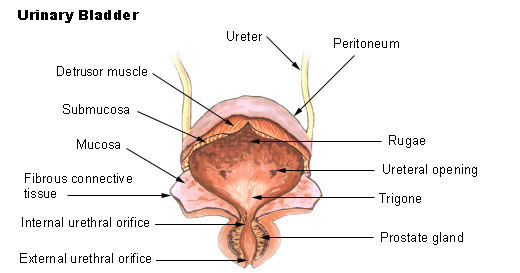- Urinary bladder
Infobox Anatomy
Name = Urinary bladder
Latin = vesica urinaria
GraySubject = 255
GrayPage = 1227

Caption = Urinary system.

Caption2 = Bladder
Width = 300
System =
Artery =Superior vesical artery Inferior vesical artery Umbilical artery Vaginal artery
Vein =Vesical venous plexus
Nerve =Vesical nervous plexus
Lymph =external iliac lymph nodes ,internal iliac lymph nodes
Precursor =urogenital sinus
MeshName = Bladder
MeshNumber = A05.810.161
DorlandsPre = v_07
DorlandsSuf = 12855244
Inanatomy , the urinary bladder is a hollow, muscular, and distensible (or elastic) organ that sits on thepelvic floor inmammal s. It is the organ that collectsurine excreted by thekidney s prior to disposal byurination . Urine enters the bladder via theureter s and exits via theurethra .In males, the bladder is superior to the
prostate , and separated from therectum by therectovesical excavation .In females, the bladder is separated from the
uterus by thevesicouterine excavation .Detrusor muscle
The
detrusor muscle is a layer of the urinary bladder wall made ofsmooth muscle fibers arranged in spiral, longitudinal, and circular bundles. When the bladder is stretched, this signals theparasympathetic nervous system to contract thedetrusor muscle . This encourages the bladder to expelurine through theurethra .For the urine to exit the bladder, both the
autonomic ally controlled internalsphincter and the voluntarily controlled external sphincter must be opened. Problems with these muscles can lead to incontinence. If the amount of urine reaches 100% of the urinary bladder volume, the voluntary sphincter becomes involuntary and the urine will be ejected instantly, although it is possible to "hold yourself" in order to prevent urination. The body cannot afford having the urinary bladder burst.The urinary bladder usually holds 400–620 mL of urine, but it can hold twice this without rupturing if, for example, the outflow is obstructed.
The desire to urinate usually starts when the bladder reaches around 75% of its working volume. If the subject is distracted the desire can fade and return with more urgency as the bladder continues to fill.
Since the urinary bladder has a
transitional epithelium , compared to the intestine mucosa, the urinary bladder does not produce mucus. [ [http://www.sciencedirect.com/science?_ob=ArticleURL&_udi=B6WKP-4PMK2X4-Y&_user=10&_rdoc=1&_fmt=&_orig=search&_sort=d&view=c&_acct=C000050221&_version=1&_urlVersion=0&_userid=10&md5=89f27dee46151805e831331aace3a19f T . Chin , C . Liu , H . Tsai , C . Wei. Vaginal reconstruction using urinary bladder flap in a patient with cloacal malformation] ]Fundus
The fundus of the urinary bladder is the base of the bladder, formed by the posterior wall. It is
lymphatically drained by theexternal iliac lymph nodes . The peritoneum lies superior to the fundus.Disorders
Disorders of or related to the bladder include:
*Overactive bladder , a condition which affects a large number of people.
*Bladder cancer
*Bladder infection
*Bladder spasm
*Bladder sphincter dyssynergia , a condition in which the sufferer cannot coordinate relaxation of the urethra sphincter with the contraction of the bladder muscles
*Bladder stone s
*Cystitis
*Hematuria , or presence of blood in the urine, is a reason to seek medical attention without delay, as it is a symptom of bladder cancer as well as bladder andkidney stone s.
*Urinary incontinence
*Bladder exstrophy jakes is hugee.Uses
Besides its normal use to the possessor, animal bladders (usually
pig bladders) have been used to make balls (such as footballs, and even a musical instrument, thebumbass .ee also
*
Artificial bladder
*Bladder augmentation
*Neurogenic bladder
*Ureterocele
*Urodynamics The study of the functional aspects of the detrusor muscle.
*Uvula of urinary bladder
*Vesicouretic reflux
*Urinary bladder disease References
External links
* "Urinary Bladder"
* - "Mammal, bladder (LM, Medium)"
*
* - "The Female Pelvis: The Urinary bladder"
* - "The Male Pelvis: The Urinary bladder"
=Additional
Wikimedia Foundation. 2010.
